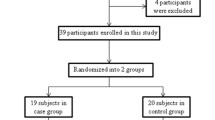Summary
This study aimed to evaluate the clinical efficacy of acupuncture for intervening insulin resistance (IR) by meta-analysis of related randomized controlled trials (RCTs). Studies published prior to 31 January 2018 were searched on Pubmed, Medline, Cochrane Library, Embase databases and Chinese databases. Only RCTs, which examined acupuncture as the sole or adjunctive treatment for IR-related diseases, were included. The primary outcome was homeostasis model assessment for insulin resistance (HOMA-IR). The secondary outcomes consisted of fasting blood glucose (FBG), fasting insulin (FINS) and 2-h postprandial blood glucose (2h-PBG). The differences between groups were reported as mean differences (MD). All statistical analyses were performed using RevMan software 5.3. After carefully screening relevant studies, 9 RCTs involving 562 patients (279 in experimental group and 283 in control group) were enrolled in this study. The pooled results showed that acupuncture had significant effects on HOMA-IR (MD 0.70, 95% CI 0.04 to 1.35, P=0.04<0.05), FINS (MD 3.35 mU/L, 95% CI 1.99 to 4.7, P<0.001) and 2h-PBG (MD 1.03 mmol/L, 95% CI 0.25 to 1.82, P=0.01). However, the differences in FBG were not significant (MD 0.28 mmol/L, 95% CI–0.28 to 0.84, P=0.32>0.05). The present meta-analysis indicated that acupuncture can help to improve IR to a certain extent, which remains to be confirmed by further high-quality RCTs.
Similar content being viewed by others
References
Moghetti P. Insulin resistance and polycystic ovary syndrome. Curr Pharm Des, 2016,22(36):5526–5534
Xie JH, Liu Q, Yang Y. Correlation of liver enzymes with diabetes and pre-diabetes in middle-aged rural population in China. J Huazhong Univ Sci Technolog Med Sci, 2016,36(1):53–58
Chen W, Balland E, Cowley MA. Hypothalamic insulin resistance in obesity: Effects on glucose homeostasis. Neuroendocrinology, 2017,104(4):364–381
Zhao Y, Hou L, Gao HJ, et al. Independent relationship between body mass index and LH peak value of GnRH stimulation test in ICPP girls: A cross-sectional study. J Huazhong Univ Sci Technolog Med Sci, 2017,37(4):556–562
Kelly T, Yang W, Chen CS, et al. Global burden of obesity in 2005 and projections to 2030. Int J Obes, 2008,32(9):1431–1437
Lazo M, Clark JM. The epidemiology of nonalcoholic fatty liver disease: a global perspective. Semin Liver Dis, 2008,28(4):339–350
Fonseca V, Desouza C, Asnani S, et al. Nontraditional risk factors for cardiovascular disease in diabetes. Endocr Rev, 2004,25(1):153–175
Goodarzi MO, Bryer-Ash M. Metformin revisited: reevaluation of its properties and role in the pharmacopoeia of modern antidiabetic agents. Diabetes Obes Metab, 2005,7(6):654–665
Xiao WH, Wang YR, Hou WF, et al. The effects of pioglitazone on biochemical markers of bone turnover in the patients with type 2 diabetes. Int J Endocrinol, 2013,2013:290734
Xu Z, Li R, Zhu C, et al. Effect of acupuncture treatment for weight loss on gut flora in patients with simple obesity. Acupunct Med, 2013,31(1):116–117
Kumar R, Mooventhan A, Manjunath NK. Immediate effect of needling at CV-12 (Zhongwan) acupuncture point on blood glucose level in patients with type 2 diabetes mellitus: A pilot randomized placebo-controlled trial. J Acupunct Meridian Stud, 2017,10(4):240–244
Hao C, Zhang T, Qi J, et al. Acupuncture at Zhibian (BL 54) through Shuidao (ST 28) for polycystic ovary syndrome. Zhongguo Zhen Jiu (Chinese), 2015,35(5):461–464
Firouzjaei A, Li GC, Wang N, et al. Comparative evaluation of the therapeutic effect of metformin monotherapy with metformin and acupuncture combined therapy on weight loss and insulin sensitivity in diabetic patients. Nutr Diabetes, 2016, 6:e209
Zheng YH, Wang XH, Lai MH, et al. Effectiveness of abdominal acupuncture for patients with obesity-type polycystic ovary syndrome: A randomized controlled trial. J Altern Complem Med, 2013,19(9):740–745
Garcia-Vivas JM, Galaviz-Hernandez C, Becerril-Chavez F, et al. Acupoint catgut embedding therapy with moxibustion reduces the risk of diabetes in obese women. J Res Med Sci, 2014,19(7):610–616
Liberati A, Altman DG, Tetzlaff J, et al. The PRISMA statement for reporting systematic reviews and meta-analyses of studies that evaluate health care interventions: explanation and elaboration. J Clin Epidemiol, 2009,62(10):e1–e34
Song AQ, Liang FX. Is acupuncture effective for improving insulin resistance? A systematic review and meta-analysis. PROSPERO: CRD42018088172 https://doi.org/www.crd.york.ac.uk/PROSPERO/display_record.php?RecordID=88172
Higgins JP, Green S. Cochrane Handbook for Systematic Reviews of Interventions. Version 5.1.0: The Cochrane Collaboration, 2011
Chen R, Wang C, Yan QY. Observation on therapeutic effect of polycystic ovary syndrome of damp-phlegm constitution treated with embedding therapy on backshu points and front-mu points combined with needlepricking therapy on Sifeng (EX-UE 10). Zhongguo Zhen Jiu (Chinese), 2014,34(4):355–358
Yang J, Liu Y, Huang J, et al. Acupuncture and Chinese medicine of artificial cycle therapy for insulin resistance of polycystic ovary syndrome with phlegm damp type and its mechanism. Zhongguo Zhen Jiu (Chinese), 2017,37(11):1163–1168
Cai H, Zhao LJ, Zhao ZM, et al. Effect of acupuncture on serum leptin level in patients with type II diabetes mellitus. Zhen Ci Yan Jiu (Chinese), 2011,36(4):288–291
Lin RT, Pai HC, Lee YC, et al. Electroacupuncture and rosiglitazone combined therapy as a means of treating insulin resistance and type 2 diabetes mellitus: A randomized controlled trial. Evid-based Compl Alt, 2013,2013:969824
Yang Y, Liu YX. BO's abdominal acupuncture for obese type-2 diabetes mellitus. Zhongguo Zhen Jiu (Chinese), 2015,35(4):330–334
Li Q, Li L, Luo YP, et al. Effects of electroacupuncture on glycometabolism in metabolism syndrome. World J Acupunct Moxibustion, 2014,24(3):1–5
Author information
Authors and Affiliations
Corresponding author
Additional information
This work was supported by the National Natural Science Foundation of China (No. 81774420 and No. 81574065).
Rights and permissions
About this article
Cite this article
Song, Aq., Zhang, Yp., Chen, R. et al. Is Acupuncture Effective for Improving Insulin Resistance? A Systematic Review and Meta-analysis. CURR MED SCI 38, 1109–1116 (2018). https://doi.org/10.1007/s11596-018-1991-1
Received:
Revised:
Published:
Issue Date:
DOI: https://doi.org/10.1007/s11596-018-1991-1




